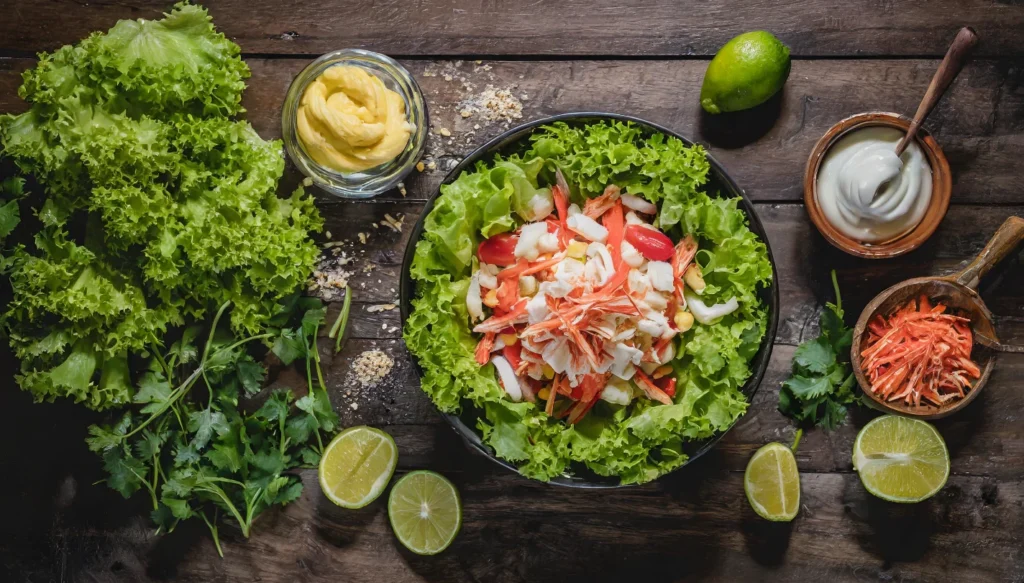
Understanding Imitation Crab
Imitation crab, a seafood product crafted to mimic the taste, texture, and appearance of genuine crab meat, is a staple in various cuisines around the globe. Made from surimi—a fish paste usually derived from white-fleshed fish like pollock—imitation crab is both versatile and affordable. It stands as a popular choice for seafood lovers on a budget or those seeking a convenient alternative to shellfish.
Not only does imitation crab provide a delicious seafood experience, but it also offers a nutritional profile that includes proteins, minimal fat, and several vitamins and minerals. However, it’s essential to consider its content of additives and preservatives, aimed at enhancing flavor and extending shelf life.
History and Origin
The inception of imitation crab in Japan, where it is known as “kamaboko,” dates back several centuries. Initially created as a method to preserve surplus catch, the technique evolved, spreading globally by the late 20th century. Today, imitation crab enjoys popularity in a myriad of dishes, from sushi rolls to seafood salads, marking its status as a beloved ingredient worldwide.
In preparing dishes with imitation crab, it’s crucial to select high-quality products. Look for options that list fish as the first ingredient and have a minimal amount of additives. Understanding the product’s packaging and labels can provide insights into its quality and nutritional value, ensuring a healthier choice.
How to Choose the Best Imitation Crab

Selecting the highest quality imitation crab is pivotal to crafting delicious and healthy dishes. Here are some tips to guide you:
- Check the Packaging and Labels: Opt for products that list fish as the primary ingredient and have the least amount of fillers and artificial additives.
- Freshness Indicators: Though imitation crab is pre-cooked, ensuring its freshness is vital. Look for a recent production date and intact packaging.
Preparation and Cooking Tips
Before diving into the vast world of imitation crab recipes, familiarizing yourself with the basics of preparation and cooking can significantly enhance the taste and safety of your dishes.
Preparation Basics
- Thawing: If your imitation crab is frozen, thaw it in the refrigerator overnight to maintain its texture and flavor.
- Handling: Rinse the imitation crab under cold water and pat dry with paper towels before use.
Cooking Tips and Techniques
- Best Practices: Imitation crab can be eaten straight from the package or heated. When cooking, gentle heat is key to prevent it from becoming tough.
- What to Avoid: Direct high heat or prolonged cooking times can deteriorate the texture and flavor.

Imitation Crab Recipes
Delve into the delicious versatility of imitation crab with these carefully curated recipes that showcase its potential in salads, main courses, and more.
Salads and Appetizers
- Imitation Crab Salad:
- Mixed greens
- Diced cucumber
- Shredded imitation crab
- A creamy dressing of your choice
- Crab Rangoon with Imitation Crab:
- Wonton wrappers
- Cream cheese
- Finely chopped imitation crab
- Green onions and seasoning
Main Courses
- Imitation Crab Pasta:
- Cooked pasta of choice
- Olive oil and garlic
- Shredded imitation crab
- Cherry tomatoes and fresh basil
- Imitation Crab Sushi Rolls:
- Sushi rice
- Nori sheets
- Shredded imitation crab mixed with mayonnaise
- Cucumber, avocado, and sesame seeds
Soups and Sides
- Crab Bisque with Imitation Crab:
- Sautéed onions and garlic
- Tomato paste and flour
- Seafood stock and cream
- Shredded imitation crab and seasoning
- Crab Cake using Imitation Crab:
- Shredded imitation crab
- Bread crumbs and mayonnaise
- Diced bell peppers, onions, and seasoning
- Pan-fried until golden brown
FAQs
Can you eat imitation crab raw?
No, it’s not advisable to eat imitation crab raw. While it’s already cooked during the manufacturing process, consuming it raw can still pose health risks due to potential contamination during handling or packaging. It’s best to cook imitation crab thoroughly before consuming to ensure safety.
How long does imitation crab last in the fridge?
Typically, imitation crab has a relatively short shelf life once opened. Once the package is opened, it should be consumed within 2-3 days for optimal freshness. Proper storage in an airtight container in the refrigerator can help extend its shelf life, but it’s best to check for any signs of spoilage before consuming.
Is imitation crab suitable for those with shellfish allergies?
While imitation crab is made from fish, it often contains other ingredients such as wheat and egg whites, which can trigger allergies in some individuals. Additionally, it’s processed in facilities that handle shellfish, increasing the risk of cross-contamination. Therefore, individuals with shellfish allergies should exercise caution and check the ingredients label carefully before consuming imitation crab products.
Health and Nutritional Information
Imitation crab offers a convenient and affordable alternative to real crab for those looking to enjoy seafood dishes without breaking the bank. However, it’s important to note that imitation crab may not provide the same nutritional benefits as real crab. While it’s lower in cholesterol and calories, it also tends to be higher in sodium and artificial additives.
Imitation crab is typically made from a blend of fish, starches, and flavorings. While it varies by brand and product, it generally contains protein, carbohydrates, and small amounts of fat. However, it may lack the essential nutrients found in real crab, such as omega-3 fatty acids, vitamin B12, and zinc.
In terms of taste and texture, imitation crab closely resembles real crab meat, making it a popular choice for sushi rolls, salads, and seafood dishes. However, real crab offers superior nutritional value, providing a rich source of protein, vitamins, and minerals without the added sodium and preservatives often found in imitation crab products.
Sustainability and Ethical Considerations
Environmental Impact
The production of imitation crab involves processing various types of fish, which can have environmental consequences such as overfishing and habitat destruction. Additionally, the use of additives and preservatives in imitation crab products may contribute to pollution and waste in the environment. However, some manufacturers are working to minimize their environmental footprint by sourcing fish responsibly and implementing sustainable fishing practices.
Ethical Considerations
When it comes to ethical considerations, sourcing of ingredients is a key factor to consider. While imitation crab may not directly involve the harvesting of shellfish, it often contains fish sourced from aquaculture or wild-caught fisheries. Consumers concerned about ethical issues such as overfishing and bycatch should look for products that prioritize sustainable sourcing practices and adhere to ethical standards in their production processes. Additionally, choosing products certified by reputable organizations such as the Marine Stewardship Council (MSC) can help ensure that ethical and sustainable practices are being followed throughout the supply chain.
Conclusion
In conclusion, the world of imitation crab offers a diverse array of culinary possibilities, from refreshing salads to hearty main courses and comforting soups. By understanding its origins, selecting quality products, and mastering preparation techniques, enthusiasts can explore Branzino The Mediterranean Delight or The Delight of Crab Imperial. Moreover, addressing common questions about safety, nutritional content, and ethical considerations empowers consumers to make informed choices that align with their values and dietary needs.
Beyond its culinary appeal, the exploration of imitation crab prompts reflection on broader issues such as sustainability and ethical sourcing. By engaging with these considerations, individuals can appreciate the interconnectedness of food choices with environmental and ethical concerns. Thus, embracing imitation crab becomes not only a culinary adventure but also an opportunity to cultivate mindfulness and responsibility in our dining habits.

Easy Imitation Crab Recipes for Seafood Lovers
- Total Time: 45 minutes
- Yield: 4 servings 1x
Description
Imitation crab, a seafood product crafted to mimic the taste, texture, and appearance of genuine crab meat, is a staple in various cuisines around the globe. Made from surimi—a fish paste usually derived from white-fleshed fish like pollock—imitation crab is both versatile and affordable. It stands as a popular choice for seafood lovers on a budget or those seeking a convenient alternative to shellfish.
Ingredients
1 pound imitation crab meat, shredded
2 cups mixed greens (lettuce, spinach, arugula)
1 medium cucumber, diced
1 large avocado, diced
1/2 cup corn (canned or fresh)
1/4 cup mayonnaise
2 tablespoons sour cream
1 tablespoon lemon juice
Salt and pepper to taste
Optional: 2 tablespoons fresh dill, chopped
Instructions
Step 1: Prepare the Ingredients
Shred the Imitation Crab: Use your hands or a fork to shred the imitation crab meat into bite-sized pieces. If it’s too cold straight from the fridge, let it sit out for a few minutes to soften for easier shredding.
Dice the Vegetables: Wash and dice the cucumber and avocado into small, bite-sized pieces. If using fresh corn, boil it for a few minutes, let it cool, and then cut off the kernels.
Step 2: Mix the Salad
Combine Vegetables and Crab: In a large mixing bowl, add the shredded imitation crab, diced cucumber, avocado, and corn. Gently toss to combine.
Make the Dressing: In a small bowl, whisk together mayonnaise, sour cream, and lemon juice until smooth. Season with salt and pepper to taste. If using, add the chopped dill to the dressing for extra flavor.
Dress the Salad: Pour the dressing over the crab and vegetable mixture. Toss gently until everything is well coated with the dressing. Adjust seasoning if necessary.
Step 3: Serve
Chill (Optional): For a refreshing taste, you can chill the salad in the refrigerator for about 30 minutes before serving.
Garnish and Serve: Serve the salad on a bed of mixed greens. Garnish with additional dill or a lemon wedge if desired.
- Prep Time: 15 minutes
- Cook Time: 30 minutes
- Category: SEAFOOD
- Method: FRYING / BOILING
- Cuisine: International
Nutrition
- Serving Size: 1 cup
- Calories: 200 kcal
- Sugar: 5g
- Sodium: 500mg
- Fat: 10g
- Saturated Fat: 2g
- Unsaturated Fat: 7g
- Trans Fat: 0g
- Carbohydrates: 20g
- Fiber: 1g
- Protein: 8g
- Cholesterol: 15mg
Keywords: imitation crab recipes, surimi seafood dishes, fake crab cooking ideas, crab stick meals
